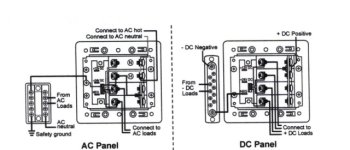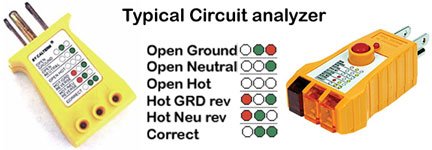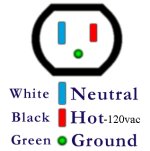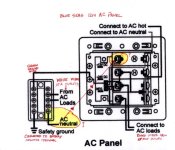I finally got around to installing and wiring the 30 amp Shorepower system. It's basically exactly the same set-up that Ferret30 installed a couple of years ago. Ferret30 shore power recap I tried PM'ing Ferret30 for his insight since I used the same hardware as he did but so far haven't heard back.
I only had a minute to test the system and of course, the outlets weren't working. I didn't have time to run a voltmeter on it but here are the symptoms. The indicator lights for the power and the individual load buttons light up when switched on. However, there doesn't seem to be any power to the loads. I used both of the positions for GFCI outlets. Because I ran out of time, I only completed hooking up the first outlet (with a piggybacked outlet). I'm not sure it's wired correctly even though I followed the wiring schematic. Can you help me figure out what I did wrong?
If you look at the schematic for the AC Panel on the left side, it show a dual bus bar. I wired All of the green ground wires, from the inlet, from the AC Panel and from the AC loads (outlets) to the left side of the bus bar. I then ran a 10 gauge green wire to the DC ground.
I wired the two neutral (white) wires from the loads (outlets) to the right side of the bus bar. In the diagram, there is a line marked as "AC neutral" coming down from the last terminal on the right hand side of the bus bar. Am I missing something here? Should there be a wire from the right side of the bus bar (AC neutral) going to DC ground? Or a white wire back to the AC panel? Would the indicator lights not work if the ground was wired properly to DC ground?
I wired the black wire from the inlet to the 2nd screw labeled AC hot on the AC panel. I wired the white wire from the inlet to the top screw labeled AC neutral on the AC panel. I don't see an additional wire going to the bus bar other than the green with yellow stripe wire included with the AC panel. Please HELP!!

One more thing crossed my mind after reading some of the threads on this shore power installation. Is it possible that it's all wired correctly and I just need to really push the reset button on the GFCI outlet? It would be nice if it were that simple.
--- Peter
I only had a minute to test the system and of course, the outlets weren't working. I didn't have time to run a voltmeter on it but here are the symptoms. The indicator lights for the power and the individual load buttons light up when switched on. However, there doesn't seem to be any power to the loads. I used both of the positions for GFCI outlets. Because I ran out of time, I only completed hooking up the first outlet (with a piggybacked outlet). I'm not sure it's wired correctly even though I followed the wiring schematic. Can you help me figure out what I did wrong?
If you look at the schematic for the AC Panel on the left side, it show a dual bus bar. I wired All of the green ground wires, from the inlet, from the AC Panel and from the AC loads (outlets) to the left side of the bus bar. I then ran a 10 gauge green wire to the DC ground.
I wired the two neutral (white) wires from the loads (outlets) to the right side of the bus bar. In the diagram, there is a line marked as "AC neutral" coming down from the last terminal on the right hand side of the bus bar. Am I missing something here? Should there be a wire from the right side of the bus bar (AC neutral) going to DC ground? Or a white wire back to the AC panel? Would the indicator lights not work if the ground was wired properly to DC ground?
I wired the black wire from the inlet to the 2nd screw labeled AC hot on the AC panel. I wired the white wire from the inlet to the top screw labeled AC neutral on the AC panel. I don't see an additional wire going to the bus bar other than the green with yellow stripe wire included with the AC panel. Please HELP!!

One more thing crossed my mind after reading some of the threads on this shore power installation. Is it possible that it's all wired correctly and I just need to really push the reset button on the GFCI outlet? It would be nice if it were that simple.
--- Peter





